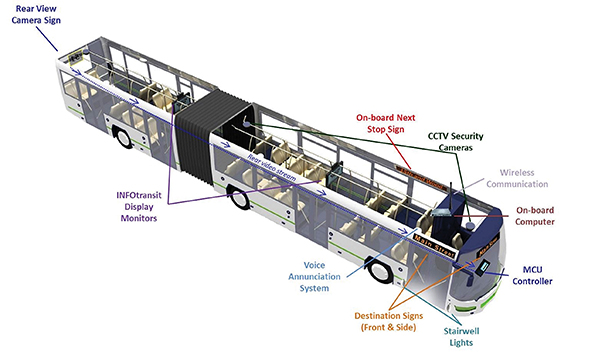
Travelers need current information communication
Bus passengers need to know the current status of their trip information- when their bus will arrive at their stop/depot, what stops and connections are on their route, unexpected delays or emergencies due to traffic, weather, mechanical issues, accidents, etc. A passenger information system is no longer just a “nice thing to have”, but rather a critical customer service communication tool to instill confidence that passengers will get to where they need to be- reliably, safely, and on-time! Also, not every traveler is going to have a fully-charged mobile phone with the transit agency’s mobile app already discovered and downloaded before their trip begins. Printed timetable schedules can quickly become outdated or unreliable and nobody wants to stand around wondering if their bus arrived early, if it is late, or if it will come at all!

The future’s technology today
Today’s mass transit buses typically have a GPS tracker installed that enables the transit agency (TA) to see on an automated vehicle location “virtual map” exactly where each active vehicle (asset) is at on each route. Arrival prediction software algorithms account for traffic and weather variables to accurately predict when each bus will arrive. By feeding this information to Luminator’s INFOtransit onboard passenger information system (and fixed digital stationary signs) every traveler can be updated in real-time of their current trip information. If a service disruption occurs, the TA can send out a quick update to inform all passengers of the impact and available rescheduling alternatives.
Much more than just passenger ‘infotainment’
By now you’ve likely heard that vibrant, high definition onboard infotainment screens can be very impressive visually and are a great revenue generating platform for advertising. Local business owners will pay to draw in traffic from nearby bus routes for lunch, shopping, sporting events, and other activities. Customized advertising content (pictures, video, graphics, text,…) can be easily created, edited, and uploaded then triggered for display based on time or location at the precisely targeted moment (for example- just prior to the nearest stop to the advertiser’s business location). Public safety and policy messaging can also be displayed by the TA for the benefit of new riders. Announcements can also be made audibly for riders with vision impairment or other disabilities in compliance with US DOT ADA regulations. Text to speech data conversion enables the streamed content to be converted to almost any language needed.
As shown in the diagram, onboard CCTV camera systems, rear view cameras, voice annunciation systems, and other onboard equipment can also be integrated with the passenger infotainment system. This provides a comprehensive network of services to ensure the safety of passengers, drivers, and property as well as real-time information updates and enhanced ridership experience. Wireless communication devices also enable system diagnostics reporting back to the TA for preventive maintenance and remote troubleshooting.
Cliff Anderson is marketing manager for Luminator Technology Group, a provider of mass transit destination signs, on board infotainment and passenger information systems.
